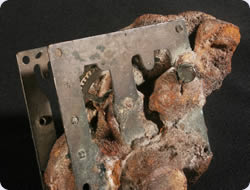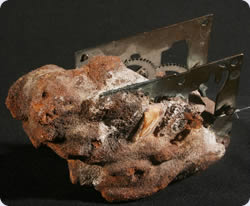“Fossil” Clock: How fast do rocks form?
Q: A “fossil” clock—what does it mean?


A: Because of the intense evolutionary indoctrination we’ve all received, most people assume that it takes millions of years for sediment—like sand or mud—to harden into rock. But given the right ingredients, this can actually happen quickly. Mixing cement is an obvious example, by the way.
Take a look at the picture of the mechanism of a clock encased in solid rock, along with sea shells. Of course, no one believes this clock was made millions of years ago. The clock was found in 1975 near a jetty at Westport, Washington. We know that there have been many shipwrecks in this area.
Technically, this clock is not a fossil. By definition a fossil is any remains, impression, or trace of a living thing, and this clock therefore does not qualify.
But it has been encased in sediment that rapidly turned to rock. Obviously, the right mix of chemicals dissolved in water that wet the sand reacted to harden the sand around this clock, making it a clock in hard rock!
There’s really nothing spectacular about this at all—these sorts of things happen in different parts of the world all the time given the right conditions. But the average person doesn’t usually hear about them, and thus they go on thinking that rocks (and fossils) must take millions of years to form.
Adapted from the radio program, Answers with Ken Ham, which is heard daily on over 900 stations worldwide. Visit AnswersRadio.com to hear recent programs and for station listings. Answers with Ken Ham and AnswersRadio.com are ministries of Answers in Genesis.
More information
Recommended Resources

Answers in Genesis is an apologetics ministry, dedicated to helping Christians defend their faith and proclaim the good news of Jesus Christ.
- Customer Service 800.778.3390
- Available Monday–Friday | 9 AM–5 PM ET
- © 2026 Answers in Genesis




